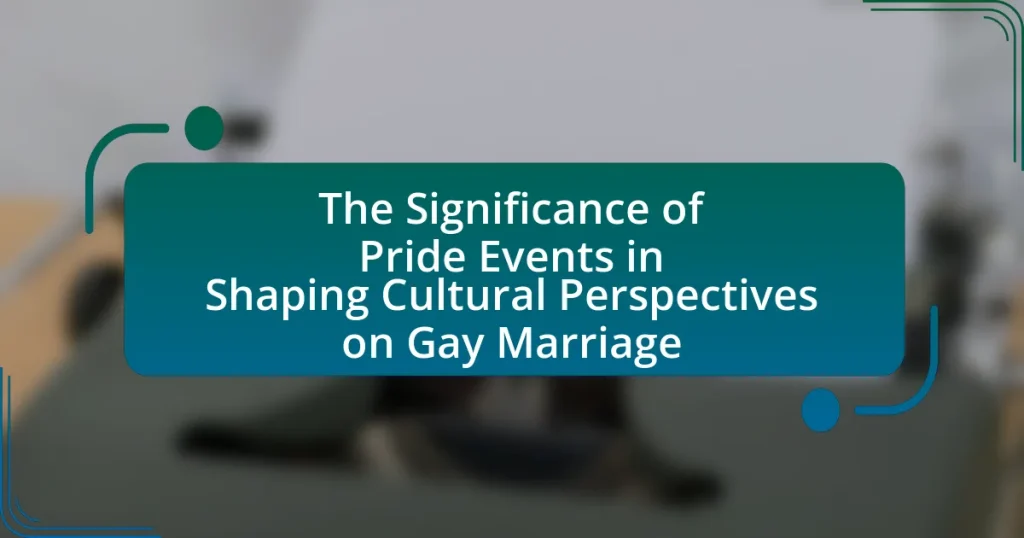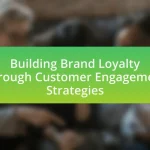Pride events play a crucial role in shaping cultural perspectives on gay marriage by promoting visibility and acceptance of LGBTQ+ identities. These events serve as platforms for advocacy, fostering dialogue around marriage equality and challenging societal norms, which has been linked to increased public support for same-sex marriage. The article explores how Pride events enhance the visibility of LGBTQ+ issues, influence public opinion, and serve as a platform for advocacy, while also addressing the challenges faced in promoting gay marriage. Additionally, it examines the evolution of Pride events over time, their cultural significance, and the strategies that can be employed to further advocate for marriage equality.
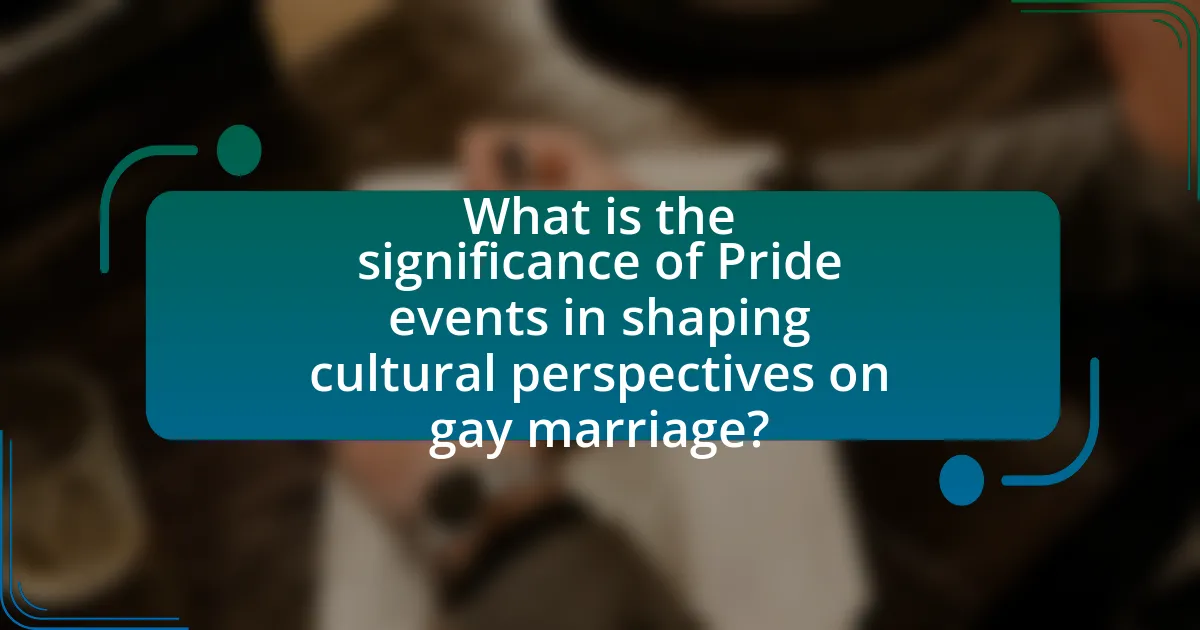
What is the significance of Pride events in shaping cultural perspectives on gay marriage?
Pride events significantly influence cultural perspectives on gay marriage by promoting visibility and acceptance of LGBTQ+ identities. These events serve as platforms for advocacy, fostering dialogue around marriage equality and challenging societal norms. For instance, the annual Pride parades, which began in the 1970s, have evolved into large-scale celebrations that attract diverse audiences, thereby normalizing LGBTQ+ relationships. Research indicates that increased visibility during Pride events correlates with higher public support for gay marriage; a 2015 Gallup poll showed that support for same-sex marriage in the U.S. rose from 27% in 1996 to 60% in 2015, coinciding with the expansion of Pride celebrations. Thus, Pride events play a crucial role in shaping and transforming cultural attitudes towards gay marriage.
How do Pride events contribute to the visibility of LGBTQ+ issues?
Pride events significantly enhance the visibility of LGBTQ+ issues by providing a platform for expression, advocacy, and community solidarity. These events attract large audiences, often numbering in the hundreds of thousands, which amplifies awareness of LGBTQ+ rights and challenges. For instance, the 2019 New York City Pride Parade drew over 5 million participants, showcasing the community’s diversity and resilience. This visibility fosters dialogue and education, helping to dismantle stereotypes and promote understanding among the broader public. Additionally, Pride events often feature speakers, workshops, and performances that highlight specific issues such as discrimination, mental health, and legal rights, further emphasizing the importance of LGBTQ+ representation in society.
What role do Pride events play in raising awareness about gay marriage?
Pride events play a crucial role in raising awareness about gay marriage by providing a platform for visibility and advocacy within the LGBTQ+ community. These events celebrate LGBTQ+ identities and foster discussions around equal rights, including the right to marry. For instance, the annual Pride parades often feature speeches and campaigns that highlight the importance of marriage equality, mobilizing public support and encouraging legislative changes. Research indicates that increased visibility during Pride events correlates with greater public acceptance of gay marriage, as evidenced by a 2015 Gallup poll showing that support for same-sex marriage in the U.S. rose significantly around the time of major Pride celebrations.
How do Pride events influence public opinion on LGBTQ+ rights?
Pride events significantly influence public opinion on LGBTQ+ rights by increasing visibility and fostering acceptance. These events serve as platforms for advocacy, showcasing the diversity and resilience of the LGBTQ+ community, which can lead to greater empathy and understanding among the general public. Research indicates that participation in or exposure to Pride events correlates with more favorable attitudes towards LGBTQ+ rights; for instance, a study published in the Journal of Social Issues found that individuals who attended Pride events reported higher levels of support for same-sex marriage and anti-discrimination policies. This shift in public opinion is often reflected in increased legislative support for LGBTQ+ rights, demonstrating the tangible impact of Pride events on societal attitudes.
Why are Pride events considered a platform for advocacy?
Pride events are considered a platform for advocacy because they promote visibility and awareness of LGBTQ+ issues, fostering dialogue and social change. These events serve as a public demonstration of solidarity, allowing individuals to express their identities and advocate for equal rights, including marriage equality. Historical context shows that Pride originated as a response to systemic discrimination, notably the Stonewall Riots in 1969, which highlighted the need for legal protections and societal acceptance. Statistics indicate that participation in Pride events correlates with increased public support for LGBTQ+ rights, including a 2019 Gallup poll showing that 70% of Americans support same-sex marriage, reflecting the impact of advocacy efforts during such events.
What messages are commonly promoted during Pride events regarding gay marriage?
Pride events commonly promote messages of equality, acceptance, and the right to love, emphasizing that gay marriage is a fundamental human right. These events advocate for the recognition of same-sex relationships and the legal rights associated with marriage, highlighting the importance of love and commitment regardless of sexual orientation. For instance, slogans like “Love is Love” and “Marriage Equality Now” are frequently used to convey the message that all couples deserve the same legal recognition and protections. The push for gay marriage has been supported by significant legal milestones, such as the U.S. Supreme Court’s decision in Obergefell v. Hodges in 2015, which legalized same-sex marriage nationwide, reinforcing the notion that marriage equality is a critical aspect of civil rights.
How do activists utilize Pride events to push for legal changes?
Activists utilize Pride events to push for legal changes by mobilizing public support, raising awareness, and advocating for specific legislative reforms. During these events, activists often organize rallies, distribute informational materials, and engage in discussions that highlight the need for legal recognition of same-sex marriage and anti-discrimination laws. For instance, the visibility of Pride parades has historically contributed to shifts in public opinion; a 2019 Gallup poll indicated that support for same-sex marriage in the U.S. reached 67%, a significant increase from 27% in 1996, reflecting the impact of sustained advocacy efforts during Pride events. Additionally, Pride events serve as platforms for coalition-building among various LGBTQ+ organizations, enhancing their collective influence on policymakers.
In what ways do Pride events foster community and solidarity?
Pride events foster community and solidarity by providing a platform for individuals to express their identities and connect with others who share similar experiences. These gatherings create a sense of belonging, as participants celebrate diversity and advocate for LGBTQ+ rights collectively. Historical evidence shows that Pride events, originating from the Stonewall riots in 1969, have evolved into significant cultural celebrations that unite people across various backgrounds, reinforcing social bonds and mutual support within the LGBTQ+ community. Additionally, studies indicate that participation in Pride events can enhance mental well-being and reduce feelings of isolation, further solidifying community ties and fostering a collective identity.
How do Pride events create a sense of belonging for LGBTQ+ individuals?
Pride events create a sense of belonging for LGBTQ+ individuals by providing a communal space where they can express their identities openly and celebrate their culture. These events foster inclusivity and solidarity, allowing participants to connect with others who share similar experiences and challenges. For instance, studies show that participation in Pride events can significantly enhance feelings of acceptance and community among LGBTQ+ individuals, contributing to improved mental health and well-being. The visibility and representation at these events also affirm the legitimacy of LGBTQ+ identities, reinforcing a collective identity that combats isolation and stigma.
What impact does community support have on the acceptance of gay marriage?
Community support significantly enhances the acceptance of gay marriage by fostering an inclusive environment that encourages open dialogue and reduces stigma. Research indicates that communities with visible support for LGBTQ+ rights, such as through pride events, experience higher levels of acceptance and understanding among their members. For instance, a study published in the Journal of Marriage and Family found that individuals living in supportive communities were 30% more likely to endorse same-sex marriage compared to those in less supportive environments. This correlation demonstrates that community backing not only influences individual attitudes but also contributes to broader societal changes regarding the recognition of gay marriage.
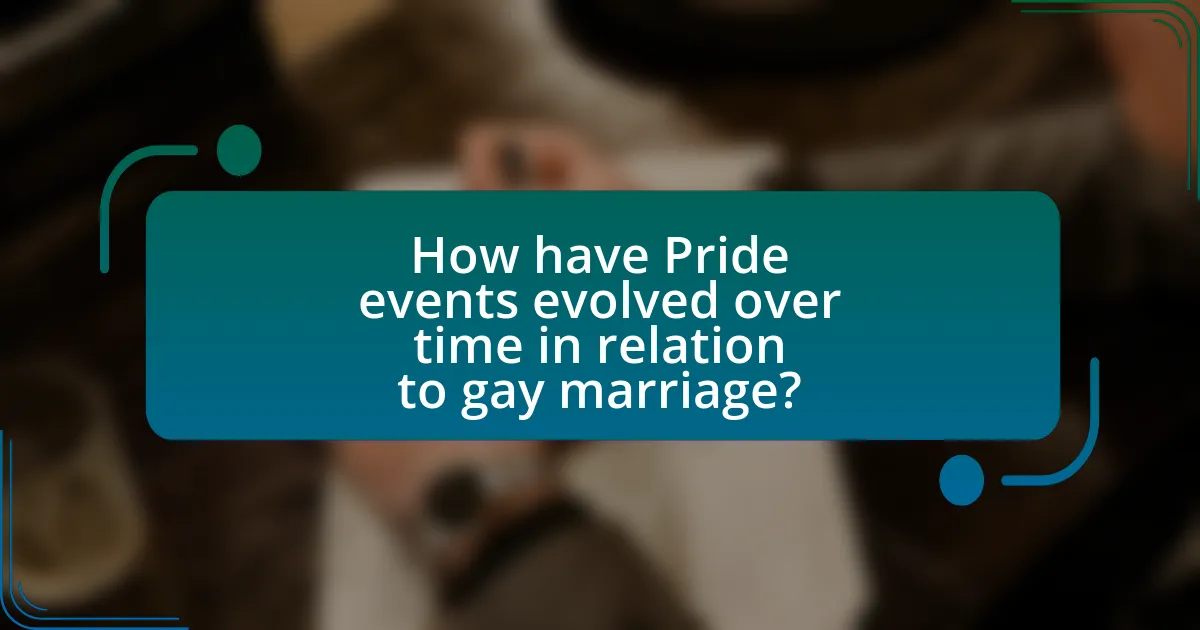
How have Pride events evolved over time in relation to gay marriage?
Pride events have evolved significantly over time in relation to gay marriage, transitioning from a focus on basic rights and visibility to celebrating legal recognition and equality. Initially, Pride events in the 1970s and 1980s primarily aimed to protest against discrimination and advocate for LGBTQ+ rights, with little emphasis on marriage. However, as societal attitudes shifted and legal battles for marriage equality gained momentum, particularly after the 2003 U.S. Supreme Court decision in Lawrence v. Texas, Pride events began to incorporate themes of marriage equality.
By the time of the landmark 2015 Supreme Court ruling in Obergefell v. Hodges, which legalized same-sex marriage nationwide, Pride celebrations had transformed into jubilant affirmations of love and commitment, showcasing weddings and marriage-related themes prominently. This evolution reflects broader cultural acceptance and the integration of marriage equality into the LGBTQ+ rights movement, illustrating how Pride events have become platforms not only for celebration but also for ongoing advocacy for full equality and acceptance within society.
What historical milestones have shaped the relationship between Pride events and gay marriage?
The historical milestones that have shaped the relationship between Pride events and gay marriage include the Stonewall Riots of 1969, which catalyzed the modern LGBTQ+ rights movement and led to the first Pride marches in the early 1970s. These events established a platform for LGBTQ+ visibility and advocacy, directly influencing the push for marriage equality. In 2003, the U.S. Supreme Court’s decision in Lawrence v. Texas decriminalized same-sex sexual activity, further legitimizing the fight for marriage rights. The 2015 Supreme Court ruling in Obergefell v. Hodges legalized same-sex marriage nationwide, marking a significant achievement celebrated during Pride events. These milestones collectively demonstrate how Pride events have served as both a celebration of LGBTQ+ identity and a rallying point for legal recognition, including marriage equality.
How did early Pride events address the issue of marriage equality?
Early Pride events addressed the issue of marriage equality by serving as platforms for advocacy and visibility for LGBTQ+ rights. These events, starting in the 1970s, included marches and demonstrations that highlighted the demand for equal rights, including the right to marry. For instance, the first Pride marches in cities like New York and San Francisco were not only celebrations but also protests against discrimination, where activists called for legal recognition of same-sex relationships. This activism laid the groundwork for future legal battles and public support, ultimately contributing to significant milestones such as the legalization of same-sex marriage in various jurisdictions.
What changes have occurred in the themes of Pride events since the legalization of gay marriage?
Since the legalization of gay marriage, the themes of Pride events have shifted from primarily focusing on the fight for legal recognition to celebrating equality and inclusivity. This transition reflects a broader acceptance of LGBTQ+ rights in society, as evidenced by increased participation from diverse communities and allies. For instance, Pride events now often emphasize intersectionality, highlighting issues such as racial justice, gender identity, and mental health within the LGBTQ+ community, which were less prominent before the legalization. Additionally, the celebration of marriage equality has led to a greater focus on family representation and the visibility of LGBTQ+ families during these events, showcasing the progress made in societal acceptance.
How do different cultures celebrate Pride events in relation to gay marriage?
Different cultures celebrate Pride events in relation to gay marriage through various forms of expression, advocacy, and community engagement. In countries like the United States, Pride parades often feature colorful floats, music, and public demonstrations advocating for LGBTQ+ rights, including the legalization of gay marriage, which was federally recognized in 2015. In contrast, in countries such as Brazil, Pride events are marked by large street parties and vibrant displays of culture, reflecting the nation’s diverse population and the ongoing fight for LGBTQ+ rights, including marriage equality, which was legalized in 2013. Additionally, in places like Spain, Pride celebrations emphasize both celebration and remembrance, honoring the history of LGBTQ+ activism that led to the legalization of same-sex marriage in 2005. These cultural expressions during Pride events highlight the significance of gay marriage as a symbol of acceptance and equality within diverse societies.
What variations exist in Pride celebrations across different countries regarding gay marriage?
Pride celebrations vary significantly across countries in relation to gay marriage, reflecting differing legal statuses and cultural attitudes. In countries like the Netherlands and Canada, where gay marriage is legal, Pride events often emphasize celebration and visibility, showcasing marriage equality as a significant achievement. Conversely, in nations such as Russia and Uganda, where gay marriage is illegal and LGBTQ+ rights are severely restricted, Pride events may focus on activism and resistance, highlighting the struggle for basic rights rather than celebrating marriage. This disparity illustrates how the legal recognition of gay marriage influences the tone and focus of Pride celebrations, shaping cultural perspectives on LGBTQ+ issues.
How do cultural attitudes towards gay marriage influence Pride event themes?
Cultural attitudes towards gay marriage significantly influence the themes of Pride events by reflecting societal acceptance and advocacy for LGBTQ+ rights. For instance, in regions where gay marriage is widely accepted, Pride themes often celebrate love, equality, and inclusivity, showcasing vibrant displays of unity and support. Conversely, in areas where cultural attitudes are more conservative, Pride themes may focus on resistance, visibility, and the fight for rights, emphasizing the ongoing struggle for acceptance and legal recognition. Historical context supports this, as the evolution of Pride themes has paralleled changes in public opinion and legal advancements regarding gay marriage, such as the legalization of same-sex marriage in various countries, which has led to more celebratory and affirming themes in Pride events.
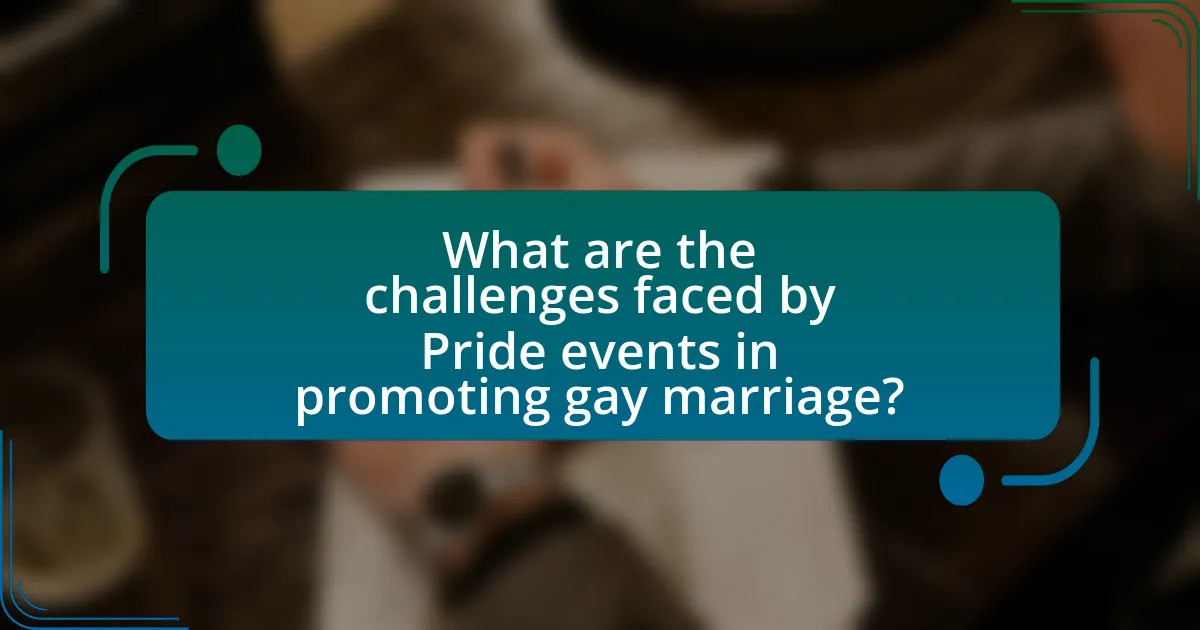
What are the challenges faced by Pride events in promoting gay marriage?
Pride events face several challenges in promoting gay marriage, primarily due to societal resistance and political opposition. Many communities still harbor conservative views on marriage, which can lead to backlash against Pride events that advocate for LGBTQ+ rights. For instance, in regions where anti-LGBTQ+ sentiments are prevalent, Pride events may encounter protests or hostility, undermining their message. Additionally, legal barriers persist in various jurisdictions, where same-sex marriage is not recognized, limiting the effectiveness of Pride events in advocating for marriage equality. According to a 2020 report by the Williams Institute, 70 countries still criminalize same-sex relationships, highlighting the global context of these challenges.
What opposition do Pride events encounter from conservative groups?
Pride events encounter significant opposition from conservative groups primarily due to their advocacy for LGBTQ+ rights and visibility, which some conservatives view as a challenge to traditional values. Conservative groups often argue that Pride events promote behaviors they consider immoral, and they may mobilize campaigns to counteract the visibility and acceptance of LGBTQ+ individuals. For instance, in various regions, conservative organizations have organized protests against Pride parades, citing concerns over the perceived sexualization of the events and the influence on children. Additionally, legislative efforts have been made in some areas to restrict or ban Pride events, reflecting a broader cultural resistance to the normalization of LGBTQ+ identities.
How do these challenges affect the messaging of Pride events?
Challenges such as discrimination, political opposition, and societal stigma significantly affect the messaging of Pride events by necessitating a focus on resilience and advocacy for equality. These challenges compel organizers to emphasize themes of visibility and acceptance, aiming to counteract negative perceptions and promote inclusivity. For instance, the ongoing legal battles for LGBTQ+ rights in various regions highlight the need for Pride events to serve as platforms for activism, reinforcing messages of solidarity and the importance of continued struggle for rights. This shift in messaging is evident in the increased presence of political statements and calls to action during Pride parades, reflecting the urgent need to address these challenges head-on.
What strategies are employed to overcome these challenges?
Strategies employed to overcome challenges in shaping cultural perspectives on gay marriage through Pride events include community engagement, educational initiatives, and coalition building. Community engagement fosters inclusivity by encouraging participation from diverse groups, which helps to normalize discussions around gay marriage. Educational initiatives, such as workshops and seminars during Pride events, provide information on LGBTQ+ rights and the importance of marriage equality, thereby addressing misconceptions and biases. Coalition building among various organizations strengthens advocacy efforts, creating a united front that amplifies the message of acceptance and equality. These strategies have been effective in increasing visibility and support for gay marriage, as evidenced by the growing public approval rates for same-sex marriage in many countries following Pride celebrations.
How can Pride events better advocate for gay marriage in the future?
Pride events can better advocate for gay marriage in the future by incorporating targeted educational campaigns that highlight the legal, social, and economic benefits of marriage equality. These campaigns can include workshops, panel discussions, and informational booths that provide attendees with data on how marriage equality positively impacts mental health, financial stability, and family rights. For instance, studies have shown that states with marriage equality experience improved mental health outcomes among LGBTQ+ individuals, as reported by the American Psychological Association. Additionally, Pride events can collaborate with local advocacy groups to mobilize attendees for legislative action, ensuring that the push for marriage equality remains a priority in political discourse. By leveraging the visibility and community engagement of Pride events, organizers can create a more informed and active base that supports the ongoing fight for gay marriage rights.
What innovative approaches can be taken to enhance the impact of Pride events?
Innovative approaches to enhance the impact of Pride events include integrating technology, such as virtual reality experiences that allow participants to engage with LGBTQ+ history and narratives in immersive ways. This method has been shown to deepen understanding and empathy, as evidenced by studies indicating that immersive experiences can significantly increase awareness of social issues. Additionally, collaborating with local businesses to create inclusive marketing campaigns can amplify visibility and support for LGBTQ+ rights, fostering community engagement and economic support. Research from the Human Rights Campaign highlights that businesses that actively support Pride initiatives see increased customer loyalty and brand recognition, further validating the effectiveness of these approaches.
How can collaboration with other social movements strengthen the message of Pride events?
Collaboration with other social movements can significantly strengthen the message of Pride events by amplifying shared goals and fostering solidarity among diverse communities. When Pride events align with movements such as racial justice, women’s rights, or environmental activism, they create a unified front that highlights the interconnectedness of various struggles for equality and justice. For instance, the 2017 Pride March in New York City included themes of racial justice, emphasizing that LGBTQ+ rights are inherently linked to broader social issues. This collaboration not only broadens the audience but also enhances the visibility of marginalized voices within the LGBTQ+ community, reinforcing the idea that the fight for gay marriage and LGBTQ+ rights is part of a larger quest for human rights.
What practical steps can individuals take to support Pride events and gay marriage advocacy?
Individuals can support Pride events and gay marriage advocacy by actively participating in local Pride celebrations, volunteering for LGBTQ+ organizations, and promoting awareness through social media. Participation in Pride events fosters community solidarity and visibility, which are essential for cultural acceptance. Volunteering with organizations like the Human Rights Campaign or local LGBTQ+ centers helps provide resources and support for advocacy efforts. Additionally, sharing informative content on social media platforms can educate others and amplify the message of equality, contributing to a broader cultural shift towards acceptance of gay marriage.
